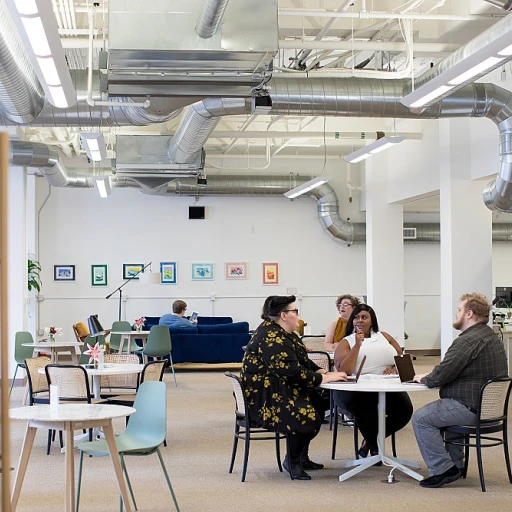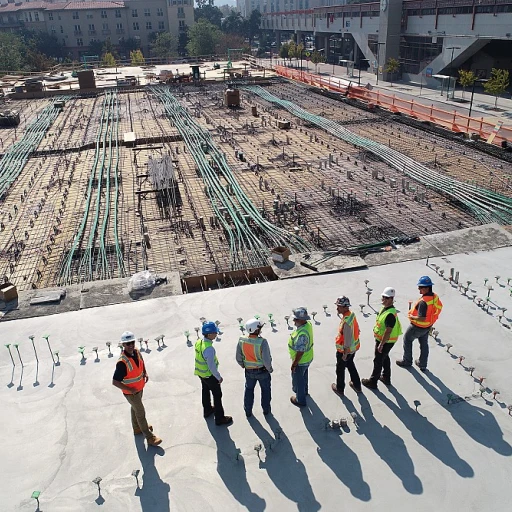
Understanding MSP Staffing Dynamics
Exploring the Dynamics of MSP Staffing
In the rapidly evolving landscape of talent management, understanding the intricacies of MSP (Managed Service Provider) staffing is crucial for business success. As organizations strive to reshape their talent strategy, MSP staffing serves as a pivotal player in connecting businesses with the right talent at the right time.
Global businesses today are investing in MSP staffing to harness the agility needed to adapt to market changes. It allows for streamlined internal mobility, making it easier to align talent acquisition strategies with workplace culture and organizational goals. With MSPs, companies can efficiently manage a variable workforce model that includes both permanent and temporary talent, a necessity in today's dynamic workplace.
Moreover, MSP staffing is shaping the future of work by providing valuable data insights into workforce trends, enhancing skills development initiatives, and optimizing employee experience. Such proactive management can be transformative for industry leaders seeking to remain future-ready in a competitive market.
Yet, while the benefits are clear, businesses must navigate certain hurdles, from retaining top talent to fostering a culture that makes them a preferred employer in the global market. Challenges aside, the effective implementation of MSP staffing can lead to sustainable growth and enable businesses to thrive.
For deeper insight into these dynamics, explore this analysis on the shifts in people operation roles and how they are integrating with MSP strategies today.
The Role of Technology in MSP Staffing
Technological Transformation and Its Impact
In today's rapidly evolving workplace, technology is not just a tool but a driving force that reshapes how businesses manage their talent. The role of technology in MSP staffing is profoundly multifaceted, influencing every aspect of talent management and skill development.- Automation and AI: The integration of artificial intelligence and automation streamlines the hiring process, enabling organizations to efficiently identify and onboard top talent. As these technologies continue to evolve, they offer innovative ways to manage talent acquisition and retention, crucial for business success in a competitive market.
- Data-Driven Decisions: With the help of advanced analytics, companies can derive meaningful insights from vast amounts of data. This data prowess aids in making informed decisions regarding employee experience and shaping future talent strategies, ensuring leaders are always a step ahead.
- Enhancing Employee Experience: Technological advancements are transforming how employees interact with their work environment. Tools facilitating internal mobility and skills development are pivotal in creating a future-ready workforce, enhancing the culture within the organization.
- Global Connectivity: Technology enables seamless communication across the globe, fostering a more connected and integrated workforce. This connectivity allows organizations to tap into a diverse pool of talent, enriching workplace culture and broadening opportunities for talent management.
While technology offers immense potential, it also presents challenges that business leaders must navigate. Balancing technological adoption with human-centric approaches remains critical in maintaining a harmonious workplace culture. For more on how to address these complexities, consider exploring navigating the complexities of staffing in the modern era.
SHRM's Vision for Talent Management
SHRM’s Strategic Approach to Talent Management
In the constantly evolving landscape of workforce management, the Society for Human Resource Management (SHRM) plays a pivotal role in shaping how organizations approach talent acquisition and retention. Recognized as a global thought leader, SHRM provides guidance on aligning talent strategies with business goals, emphasizing the importance of workforce adaptability and a future-ready approach. A fundamental aspect of SHRM’s vision is integrating technology into talent management processes. This not only enhances efficiency but also supports organizations in identifying top talent across various sectors. By leveraging data analytics and artificial intelligence, businesses can obtain valuable insights into employee performance and future hiring trends. This data-driven approach is crucial in today’s workplace, where the ability to predict future talent needs is a competitive advantage. Furthermore, SHRM emphasizes the significance of skills development and internal mobility. Encouraging continuous learning and internal career advancement can lead to more engaged employees and improved retention rates, aligning with organizations' long-term business success. Creating a workplace culture that promotes growth and development is essential for retaining top talent and ensuring the workforce is equipped for future challenges. SHRM also addresses the evolving nature of the workforce, advocating for diverse and inclusive workplace cultures. As business leaders recognize the necessity of embracing cultural diversity, it becomes a cornerstone of strategic talent management. Cultivating an environment that values diverse perspectives not only enhances employee experience but fuels innovative problem-solving – a critical driver in achieving sustained business growth. Ultimately, SHRM’s vision for talent management involves fostering a proactive and dynamic approach. By preparing existing and emerging leaders with the relevant skills and insights, organizations can better navigate the complexities of the modern business world. For more insights into how these strategies play out in one of SHRM’s focus areas, check out this detailed resource on enhancing efficiency in MSP staffing.Challenges in MSP Staffing
Addressing the Complexities of MSP Staffing
In the ever-evolving landscape of talent management, MSP staffing faces a myriad of challenges that organizations must navigate to ensure success. As businesses strive to attract and retain top talent, understanding these hurdles becomes crucial for shaping future strategies.
Talent Acquisition and Retention
One of the primary challenges in MSP staffing is the acquisition and retention of skilled talent. With the global workforce becoming increasingly competitive, businesses need to develop robust talent strategies that align with their organizational goals. This involves not only hiring the right people but also fostering a workplace culture that supports skills development and internal mobility.
Adapting to Technological Advancements
Technology plays a pivotal role in shaping the future of work, and MSP staffing is no exception. The integration of artificial intelligence and data-driven insights into talent management processes can enhance efficiency but also presents challenges in terms of implementation and adaptation. Organizations must ensure their workforce is future-ready by investing in skills development and embracing technological change.
Managing Workforce Diversity
Diversity and inclusion are key components of a successful workplace culture. However, achieving this within MSP staffing can be challenging. Business leaders must prioritize creating an inclusive environment that values diverse perspectives and experiences, which in turn can drive innovation and business success.
Aligning with SHRM's Vision
As organizations look to the future, aligning with SHRM's vision for talent management becomes essential. This involves understanding the dynamics of MSP staffing and leveraging insights from industry leaders and thought leaders to navigate the complexities of today's workplace. By doing so, businesses can enhance their talent acquisition strategies and ensure long-term success.
Future Trends in MSP Staffing
Embracing Changes in the Workforce Landscape
As organizations continue to adapt to the evolving global business environment, keeping an eye on future trends in MSP staffing is crucial. The future presents an array of challenges and opportunities that will require innovative solutions to successfully manage talent. One of the primary shifts anticipated in the workforce is the increasing use of technology to manage talent. Artificial intelligence (AI) and machine learning have been instrumental in transforming the hiring process, enabling businesses to make data-driven decisions that enhance the employee experience and retention. Industry leaders are actively exploring technology's potential to automate routine tasks, providing HR teams with more time to focus on strategic talent management. The demand for skills development is also reshaping the future of MSP staffing. Employers and SHRM talent leaders are putting a stronger emphasis on continuous learning and development to retain top talent and foster a future-ready workforce. The internal mobility of employees is becoming a strategic tool, encouraging businesses to invest in their workforce by providing opportunities for growth and career advancement within the organization. Workplace culture and employee engagement are also moving to the forefront of business strategy. Organizations are recognizing that a strong culture is key to attracting and retaining talent. As a result, they are increasingly focused on creating inclusive environments that embrace diversity and empower employees. Finally, as the workplace continues to evolve, there's a growing emphasis on the collaborative development of future work strategies guided by thought leaders and industry experts. This collaboration can help shape business success and ensure that organizations remain competitive in attracting top talent in the years to come. In conclusion, the future of MSP staffing is deeply intertwined with the advancements in technology, evolving workforce dynamics, and strategic talent management. To remain competitive, organizations must embrace these changes and proactively manage their talent strategies for sustained business success.Best Practices for MSP Staffing Success
Mastering Strategies for Effective MSP Staffing
In today's rapidly evolving workplace, staying ahead with best practices in MSP staffing is key for organizations aiming to retain top talent and thrive in a competitive market. Adapting a well-rounded approach, aligned with SHRM's vision for talent management, can significantly enhance business success.
- Embrace Advanced Technology: Utilizing artificial intelligence and data analytics for informed hiring can optimize processes and improve selection accuracy.
- Focus on Workplace Culture: Developing a positive culture is fundamental. It not only attracts but also helps retain future ready talent by enhancing their employee experience.
- Strategize for Skills Development: Offering opportunities for skills development nurtures internal talent and supports internal mobility, crucial aspects as the demand for future work evolves.
- Leverage Human Expertise: Combining tech efficiency with the human touch, aligning with thought leaders and industry leaders, complements technological insights for a human-centric strategy.
By continuously aligning these strategies within a unified talent management framework, business leaders can better navigate challenges and shape a resilient future for their workforce and themselves. With the workforce landscape shifting, refining talent strategies and leveraging global insights remain pivotal in driving long-term success.












